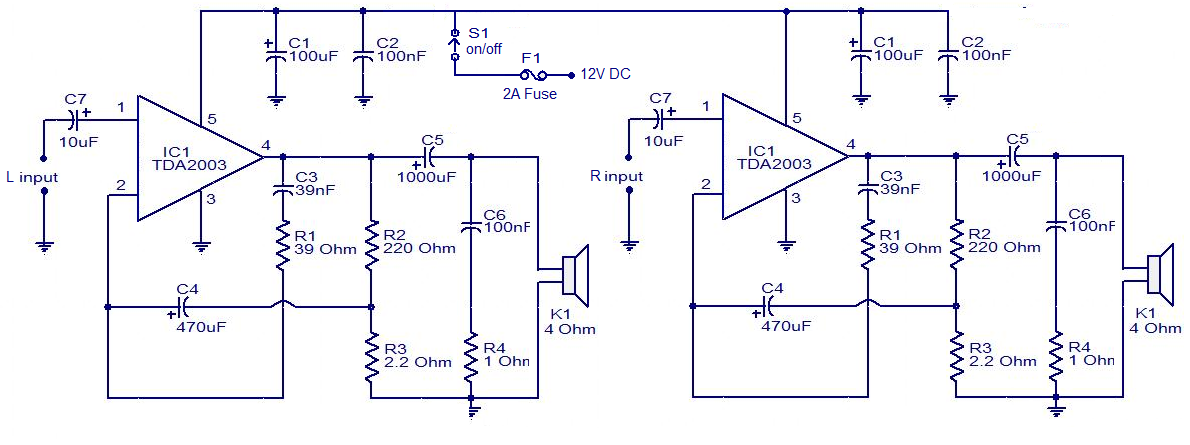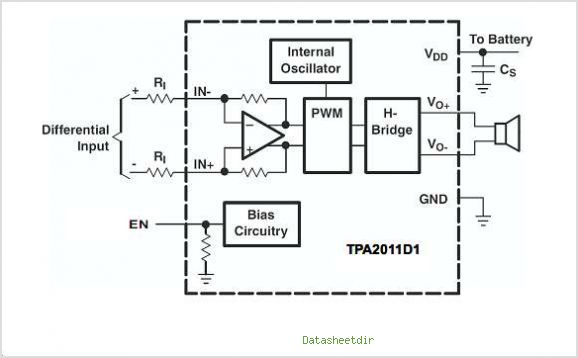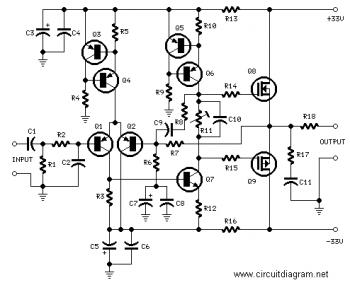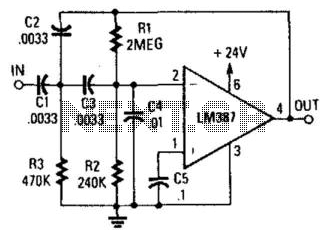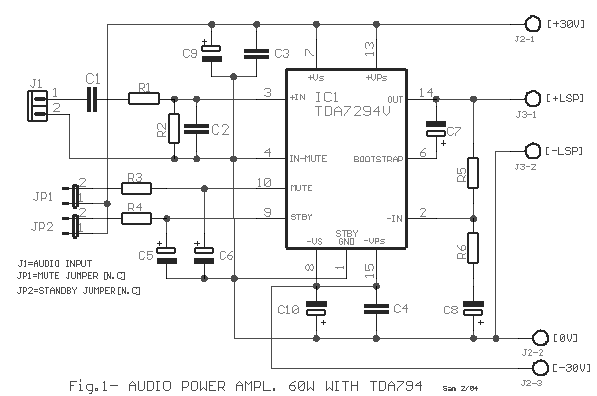
Audio Filter Analyzer
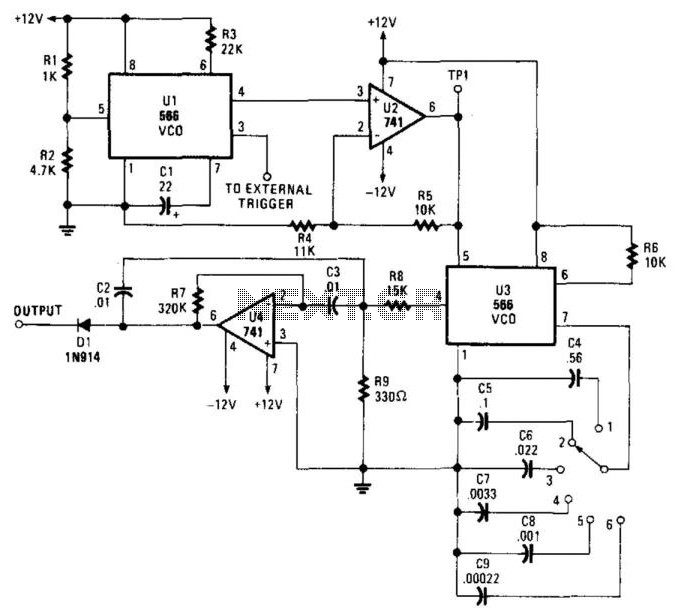
When this circuit is connected to a filter and an oscilloscope, the oscilloscope displays the filter's frequency response. A frequency that sweeps from low to high is applied to a filter. An oscilloscope is triggered by the start of the sweep and ends its trace at the highest frequency of the sweep. The filter output goes to the vertical amplifier of the oscilloscope. Using bandpass filters as an example, as the bandpass frequency is approached, reached, and passed, the oscilloscope follows the peaking output and draws the response curve. The 566 VCO (U1) produces a very low frequency (VLF) triangle wave to frequency modulate the next stage. It also produces a square wave to externally trigger the oscilloscope. Operational amplifier U2 (a 741 unit) optimizes the amplitude and the DC component. Another VCO (U3) generates the actual sweeping triangle wave, with its frequency selectable via switch S1. Operational amplifier U4 (another 741 op amp) is configured as a bandpass filter and serves as an example filter. Finally, diode D1 removes the lower half of the output, resulting in a bell curve. To set up and operate the circuit, power up the circuit and the oscilloscope. Set the oscilloscope's TIME/CM to 50 ms/cm and the VOLTS/CM control to 2 V. Connect a probe from the circuit's trigger to the oscilloscope's external trigger input and configure the triggering mode to normal, external. Attach a probe from the vertical amplifier to test point TP1. A diagonal line should appear across the CRT. Input coupling should be set to DC. Adjust the triggering level until the diagonal line runs from the upper left to the lower right of the CRT, ensuring a displayed sweep from low to high. Finally, disconnect the probe from TP1 and connect it to the filter output past the diode.
This circuit is designed to analyze the frequency response of a filter using an oscilloscope. The operation begins with a frequency sweep that ranges from low to high, which is applied to the filter. The oscilloscope captures the output of the filter, allowing for a visual representation of how the filter responds to varying frequencies.
The 566 VCO (U1) plays a crucial role in generating a VLF triangle wave that modulates the frequency of the next stage in the circuit. In addition, this VCO outputs a square wave that serves as an external trigger for the oscilloscope, ensuring synchronization between the sweep and the displayed output.
Operational amplifier U2, based on the 741 model, is utilized to optimize the output signal's amplitude and DC offset, ensuring that the oscilloscope receives a clean and accurate representation of the filter's output. The second VCO (U3) is responsible for generating the sweeping triangle wave, with its frequency adjustable via switch S1, allowing for flexibility in testing different frequency ranges.
Operational amplifier U4 is configured as a bandpass filter, providing an example of how the circuit can be used to analyze specific frequency bands. This filter setup is essential for visualizing how the filter responds as the input frequency approaches, reaches, and surpasses the bandpass range.
Diode D1 is included in the circuit to modify the output waveform, effectively clipping the lower half and resulting in a bell-shaped curve. This modification is significant for visual clarity on the oscilloscope, making it easier to analyze the filter's performance.
To operate the circuit, proper settings on the oscilloscope are necessary. The TIME/CM should be set to 50 ms/cm, and the VOLTS/CM control adjusted to 2 V, providing a suitable scale for observing the frequency sweep. The triggering configuration is also critical; by connecting the probe from the circuit's trigger to the oscilloscope's external trigger input and setting the triggering mode to normal, external, the oscilloscope can accurately display the frequency response.
After establishing the initial connections and settings, the probe should be moved from test point TP1 to the filter output past the diode. This transition allows for the observation of the filter's response as the frequency sweep progresses, providing valuable insights into the filter's characteristics and performance. When this circuit is connected to a filter and an oscilloscope, the scope displays the filter"s frequency response. A frequency that sweeps from low to high is applied to a filter. An oscilloscope is triggered by* the start of the sweep and ends its trace at the highest frequency of the sweep. The filter output goes to the vertical amplifier of the oscilloscope. Using bandpass filters as an example, as the bandpass frequency is approached, reached, and passed, the scope follows the peaking output and draws the response curve.
A neat effect! The 566 VCO (Ul) produces a VLF triangle wave to frequency modulate the next stage. It also produces a square wave to externally trigger the scope. Op amp U2 (a 741 unit) optimizes the amplitude and the dc component. Another VCO (U3) produces the actual sweeping triangle wave. Its frequency is selectable via SI. Op amp U4 (another 741 op amp) is set up as a bandpass filter and has been included as an example filter. Finally, diode D1 chops off the bottom half of the output, and leaves a nice bell curve. lb set up and operate, power-up the circuit and scope. Set the scope"s TIME/CM to 50 ms/cm. Set the VOLTS/CM control to 2 V. Attach a probe from the circuit"s trigger to the scope"s external trigger input. Set the triggering mode to normal, external. Attach a probe from the vertical amplifier to TP1. You"ll see a diagonal line that runs across the CRT. Input coupling should be set to dc. Adjust the triggering level until the diagonal runs from the upper left to the lower right of the CRT to ensure a displayed sweep from low to high.
Now, disconnect the probe from TP1 and attach it to the filter output past the diode. 🔗 External reference
This circuit is designed to analyze the frequency response of a filter using an oscilloscope. The operation begins with a frequency sweep that ranges from low to high, which is applied to the filter. The oscilloscope captures the output of the filter, allowing for a visual representation of how the filter responds to varying frequencies.
The 566 VCO (U1) plays a crucial role in generating a VLF triangle wave that modulates the frequency of the next stage in the circuit. In addition, this VCO outputs a square wave that serves as an external trigger for the oscilloscope, ensuring synchronization between the sweep and the displayed output.
Operational amplifier U2, based on the 741 model, is utilized to optimize the output signal's amplitude and DC offset, ensuring that the oscilloscope receives a clean and accurate representation of the filter's output. The second VCO (U3) is responsible for generating the sweeping triangle wave, with its frequency adjustable via switch S1, allowing for flexibility in testing different frequency ranges.
Operational amplifier U4 is configured as a bandpass filter, providing an example of how the circuit can be used to analyze specific frequency bands. This filter setup is essential for visualizing how the filter responds as the input frequency approaches, reaches, and surpasses the bandpass range.
Diode D1 is included in the circuit to modify the output waveform, effectively clipping the lower half and resulting in a bell-shaped curve. This modification is significant for visual clarity on the oscilloscope, making it easier to analyze the filter's performance.
To operate the circuit, proper settings on the oscilloscope are necessary. The TIME/CM should be set to 50 ms/cm, and the VOLTS/CM control adjusted to 2 V, providing a suitable scale for observing the frequency sweep. The triggering configuration is also critical; by connecting the probe from the circuit's trigger to the oscilloscope's external trigger input and setting the triggering mode to normal, external, the oscilloscope can accurately display the frequency response.
After establishing the initial connections and settings, the probe should be moved from test point TP1 to the filter output past the diode. This transition allows for the observation of the filter's response as the frequency sweep progresses, providing valuable insights into the filter's characteristics and performance. When this circuit is connected to a filter and an oscilloscope, the scope displays the filter"s frequency response. A frequency that sweeps from low to high is applied to a filter. An oscilloscope is triggered by* the start of the sweep and ends its trace at the highest frequency of the sweep. The filter output goes to the vertical amplifier of the oscilloscope. Using bandpass filters as an example, as the bandpass frequency is approached, reached, and passed, the scope follows the peaking output and draws the response curve.
A neat effect! The 566 VCO (Ul) produces a VLF triangle wave to frequency modulate the next stage. It also produces a square wave to externally trigger the scope. Op amp U2 (a 741 unit) optimizes the amplitude and the dc component. Another VCO (U3) produces the actual sweeping triangle wave. Its frequency is selectable via SI. Op amp U4 (another 741 op amp) is set up as a bandpass filter and has been included as an example filter. Finally, diode D1 chops off the bottom half of the output, and leaves a nice bell curve. lb set up and operate, power-up the circuit and scope. Set the scope"s TIME/CM to 50 ms/cm. Set the VOLTS/CM control to 2 V. Attach a probe from the circuit"s trigger to the scope"s external trigger input. Set the triggering mode to normal, external. Attach a probe from the vertical amplifier to TP1. You"ll see a diagonal line that runs across the CRT. Input coupling should be set to dc. Adjust the triggering level until the diagonal runs from the upper left to the lower right of the CRT to ensure a displayed sweep from low to high.
Now, disconnect the probe from TP1 and attach it to the filter output past the diode. 🔗 External reference
